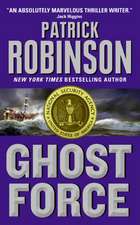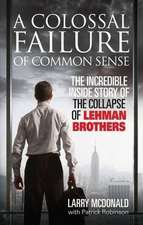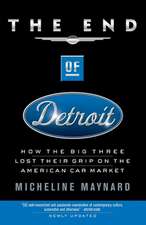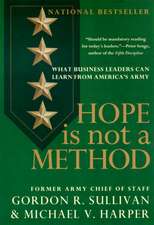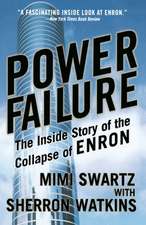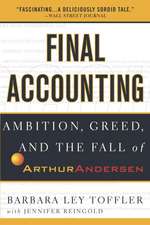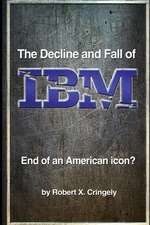A Colossal Failure of Common Sense: Three Rivers Press
Autor Lawrence G. McDonald, Patrick Robinsonen Limba Engleză Paperback – 30 sep 2010
In A Colossal Failure of Common Sense, Larry McDonald, a Wall Street insider, reveals, the culture and unspoken rules of the game like no book has ever done. The book is couched in the very human story of Larry McDonald’s Horatio Alger-like rise from a Massachusetts “gateway to nowhere” housing project to the New York headquarters of Lehman Brothers, home of one of the world’s toughest trading floors.
We get a close-up view of the participants in the Lehman collapse, especially those who saw it coming with a helpless, angry certainty. We meet the Brahmins at the top, whose reckless, pedal-to-the-floor addiction to growth finally demolished the nation’s oldest investment bank. The Wall Street we encounter here is a ruthless place, where brilliance, arrogance, ambition, greed, capacity for relentless toil, and other human traits combine in a potent mix that sometimes fuels prosperity but occasionally destroys it.
The full significance of the dissolution of Lehman Brothers remains to be measured. But this much is certain: it was a devastating blow to America’s—and the world’s—financial system. And it need not have happened. This is the story of why it did.
From the Hardcover edition.
Din seria Three Rivers Press
-
 Preț: 93.60 lei
Preț: 93.60 lei -
 Preț: 97.74 lei
Preț: 97.74 lei -
 Preț: 119.44 lei
Preț: 119.44 lei -
 Preț: 104.58 lei
Preț: 104.58 lei -
 Preț: 105.17 lei
Preț: 105.17 lei -
 Preț: 107.88 lei
Preț: 107.88 lei -
 Preț: 69.86 lei
Preț: 69.86 lei -
 Preț: 91.46 lei
Preț: 91.46 lei -
 Preț: 110.17 lei
Preț: 110.17 lei -
 Preț: 110.27 lei
Preț: 110.27 lei -
 Preț: 72.89 lei
Preț: 72.89 lei - 18%
 Preț: 66.33 lei
Preț: 66.33 lei -
 Preț: 116.57 lei
Preț: 116.57 lei - 19%
 Preț: 89.94 lei
Preț: 89.94 lei -
 Preț: 74.68 lei
Preț: 74.68 lei -
 Preț: 157.40 lei
Preț: 157.40 lei -
 Preț: 88.61 lei
Preț: 88.61 lei -
 Preț: 96.12 lei
Preț: 96.12 lei -
 Preț: 108.63 lei
Preț: 108.63 lei
Preț: 125.77 lei
Nou
Puncte Express: 189
Preț estimativ în valută:
24.07€ • 25.04$ • 19.87£
24.07€ • 25.04$ • 19.87£
Carte disponibilă
Livrare economică 22 martie-05 aprilie
Preluare comenzi: 021 569.72.76
Specificații
ISBN-13: 9780307588340
ISBN-10: 0307588343
Pagini: 351
Dimensiuni: 135 x 202 x 21 mm
Greutate: 0.32 kg
Editura: Crown Business
Colecția Three Rivers Press
Seria Three Rivers Press
ISBN-10: 0307588343
Pagini: 351
Dimensiuni: 135 x 202 x 21 mm
Greutate: 0.32 kg
Editura: Crown Business
Colecția Three Rivers Press
Seria Three Rivers Press
Recenzii
“...gives the readers a visceral sense of what it was like to work at Lehman Brothers and the fateful decisions and events that led to the company’s death spiral...”
—Michiko Kakutani, The New York Times
“Highly readable…A Colossal Failure of Common Sense largely rings true. It expresses the anger that many former Lehman employees still feel toward Mr. Fuld. And it convincingly characterizes the investment bank as a house divided against itself, between the bears who had foreseen bubbles and the bulls who wrongly believed that this time was different.”
—The Economist
“... describes a CEO acting as if his firm was too big to fail.”
—Wall Street Journal
“...poignantly told...from an insider [who] witnessed, often in amazement and disgust, the corporate dysfunction and hubristic leadership that led to [Lehman’s] demise.”
—BusinessWeek
“...engaging and even funny.”
—Fortune
From the Hardcover edition.
—Michiko Kakutani, The New York Times
“Highly readable…A Colossal Failure of Common Sense largely rings true. It expresses the anger that many former Lehman employees still feel toward Mr. Fuld. And it convincingly characterizes the investment bank as a house divided against itself, between the bears who had foreseen bubbles and the bulls who wrongly believed that this time was different.”
—The Economist
“... describes a CEO acting as if his firm was too big to fail.”
—Wall Street Journal
“...poignantly told...from an insider [who] witnessed, often in amazement and disgust, the corporate dysfunction and hubristic leadership that led to [Lehman’s] demise.”
—BusinessWeek
“...engaging and even funny.”
—Fortune
From the Hardcover edition.
Notă biografică
LAWRENCE G. McDONALD is a managing director of Pangea Capital Management LP. He was, until 2008, vice president of distressed debt and convertible securities trading at Lehman Brothers. He ran an extremely successful joint venture between the firm’s fixed income and equity divisions and was one of Lehman’s most consistently profitable traders. McDonald is also cofounder of Convertbond.com, named by Forbes magazine as “Best of the Web” from 2000 to 2003, specifically citing it as the Web’s premier source for convertible securities information, valuation, and news.
PATRICK ROBINSON wrote Lone Survivor with the U.S. Navy SEAL Marcus Luttrell.
From the Hardcover edition.
PATRICK ROBINSON wrote Lone Survivor with the U.S. Navy SEAL Marcus Luttrell.
From the Hardcover edition.
Extras
Prologue
I still live just a few city blocks away from the old Lehman Brothers
headquarters at 745 Seventh Avenue—six blocks, and about ten
thousand years. I still walk past it two or three times a week, and each
time I try to look forward, south toward Wall Street. And I always resolve
to keep walking, glancing neither left nor right, locking out the
memories. But I always stop.
And I see again the light blue livery of Barclays Capital, which
represents—for me, at least—the flag of an impostor, a pale substitute
for the swashbuckling banner that for 158 years was slashed above the
entrance to the greatest merchant bank Wall Street ever knew:
Lehman Brothers.
It was only the fourth largest. But its traditions were those of a
banking warrior—the brilliant finance house that had backed, encouraged,
and made possible the retail giants Gimbel Brothers, F. W.
Woolworth, and Macy’s, and the airlines American, National, TWA,
and Pan American. They raised the capital for Campbell Soup Company,
the Jewel Tea Company, B. F. Goodrich. And they backed the
birth of television at RCA, plus the Hollywood studios RKO, Paramount,
and 20th Century Fox. They found the money for the Trans-
Canada oil pipeline.
I suppose, in a sense, I had seen only its demise, the four-year
death rattle of twenty-first-century finance, which ended on September
15, 2008. Yet in my mind, I remember the great days. And as I
come to a halt outside the building, I know too that in the next few
moments I will be engulfed by sadness. But I always stop.
And I always stare up at the third floor, where once I worked as a
trader on one of the toughest trading floors on earth. And then I find
myself counting all the way up to thirty-one, the floor where it all went so catastrophically wrong, the floor that housed the royal court of King
Richard. That’s Richard S. Fuld, chairman and CEO.
Swamped by nostalgia, edged as we all are by a lingering anger,
and still plagued by unanswerable questions, I stand and stare upward,
sorrowful beyond reason, and trapped by the twin words of those possessed
of flawless hindsight: if only.
Sometimes I lie awake at night trying to place all the if-onlys in
some kind of order. Sometimes the order changes, and sometimes
there is a new leader, one single aspect of the Lehman collapse that
stands out above all others. But it’s never clear. Except when I stand
right here and look up at the great glass fortress which once housed
Lehman, and focus on that thirty-first floor. Then it’s clear. Boy, is it
ever clear. And the phrase if only slams into my brain.
If only they had listened—Dick Fuld and his president, Joe Gregory.
Three times they were hit with the irredeemable logic of three of
the cleverest financial brains on Wall Street—those of Mike Gelband,
our global head of fixed income, Alex Kirk, global head of distressed
trading research and sales, and Larry McCarthy, head of distressed-
bond trading.
Each and every one of them laid it out, from way back in 2005,
that the real estate market was living on borrowed time and that
Lehman Brothers was headed directly for the biggest subprime iceberg
ever seen, and with the wrong men on the bridge. Dick and Joe
turned their backs all three times. It was probably the worst triple
since St. Peter denied Christ.
Beyond that, there were six more if-onlys, each one as cringemakingly
awful as the last.
If only Chairman Fuld had kept his ear close to the ground on
the inner workings of his firm—both its triumphs and its mistakes. If
he had listened to his generals, met people who formed the heart and
soul of Lehman Brothers, the catastrophe might have been avoided.
But instead of this, he secluded himself in his palatial offices up there
on the thirty-first floor, remote from the action, dreaming only of accelerating
growth, nursing ambitions far removed from reality.
If only the secret coup against Fuld and Gregory had taken place
months before that clandestine meeting in June 2008. If the eleven
managing directors who sat in ostensibly treasonous but ultimately
loyal comradeship that night had acted sooner and removed the Lehman leaders, they might have steadied the ship, changing its course.
If only the reign of terror that drove out the most brilliant of
Lehman’s traders and risk takers had been halted earlier, perhaps in
the name of common sense. The top managers might have marshaled
their forces immediately when they saw giants such as Mike Gelband
being ignored.
If only Dick Fuld had kept his anger, resentment, and rudeness
under control. Especially at that private dinner in the spring of 2008
with Hank Paulson, secretary of the United States Treasury. That was
when Fuld’s years of smoldering envy of Goldman Sachs came cascading
to the surface and caused Paulson to leave furious that the
Lehman boss had disrespected the office he held. Perhaps that was
the moment Hank decided he could not bring himself to bail out the
bank controlled by Richard S. Fuld.
If only President George W. Bush had taken the final, desperate
call from Fuld’s office, a call made by his own cousin, George Walker
IV, in the night hours before the bank filed for Chapter 11 bankruptcy.
It might have made a difference.
If only . . . if only. Those two words haunt my dreams. I go back
to the fall of Lehman, and what might have made things different. For
most people, victims or not of this worldwide collapse of the financial
markets, it will be, in time, just water over the dam. But it will never
be that for me, and my long background as a trader and researcher has
prompted me many times to burrow down further to the bedrock, the
cause of the crash of 2008. I refer to the repeal of the Glass-Steagall
Act in 1999.
If only President Clinton had never signed the bill repealing
Glass-Steagall. Personally, I never thought he much wanted to sign it,
but to understand the ramifications it is necessary to delve deeper, and
before I begin my story, I will present you with some critical background
information, without which your grasp might be incomplete.
It’s a ten-minute meadow of wisdom and hindsight, the sort of thing I
tend to specialize in.
The story begins in the heady, formative years of the Clinton presidency on a rose-colored quest to change the world, to help the poor, and ended in the poisonous heartland of world financial disaster.
Roberta Achtenberg, the daughter of a Russian-born owner of a
Los Angeles neighborhood grocery store, was plucked by President
Clinton from relative obscurity in 1993 and elevated to the position of
assistant secretary of the Department of Housing and Urban Development.
Roberta and Bill were united in their desire to increase home
ownership in poor and minority communities.
And despite a barrage of objections led by Senator Jesse Helms,
who referred to Achtenberg as that “damn lesbian,” the lady took up
her appointment in the new administration, citing innate racism as
one of the main reasons why banks were reluctant to lend to those
without funds.
In the ensuing couple of years, Roberta Achtenberg harnessed all
of the formidable energy on the massed ranks of United States
bankers, sometimes threatening, sometimes berating, sometimes
bullying—anything to persuade the banks to provide mortgages to people
who might not have been up to the challenge of coping with up-
front down payments and regular monthly payments.
Between 1993 and 1999, more than two million such clients became
new homeowners. In her two-year tenure as assistant secretary,
she set up a national grid of offices staffed by attorneys and investigators.
Their principal aim was to enforce the laws against the banks, the
laws that dealt with discrimination. Some of the fines leveled at banks
ran into the millions, to drive home Achtenberg’s avowed intent to utilize
the law to change the ethos of providing mortgage money in the
United States of America.
Banks were compelled to jump into line, and soon they were
making thousands of loans without any cash-down deposits whatsoever,
an unprecedented situation. Mortgage officers inside the banks
were forced to bend or break their own rules in order to achieve a good
Community Reinvestment Act rating, which would please the administration
by demonstrating generosity to underprivileged borrowers
even if they might default. Easy mortgages were the invention of Bill
Clinton’s Democrats.
However, there was, in the mid- to late 1990s, one enormous advantage:
amid general prosperity, the housing market was strong and
prices were rising steadily. At that point in time, mortgage defaults
were relatively few in number and the securitization of mortgages, which had such disastrous consequences during the financial crisis that began in 2007, barely existed.
Nonetheless, there were many beady-eyed financiers who looked
askance at this new morality and privately yearned for the days when
bank policies were strictly conservative, when credit was flatly denied
to anyone without the proven ability to repay.
And at the center of this seething disquiet, somewhere between
the persuasive silken-tongued members of the banking lobby and the
missionary zeal of Roberta Achtenberg, stood William J. Clinton,
whose heart, not for the first time, may have been ruling his head.
He understood full well the goodwill he had engendered in the
new home-owning black and Hispanic communities. But he could not
fail to heed the very senior voices of warning that whispered, There
may be trouble ahead.
President Clinton wanted to stay focused with the concerns of
the bankers, many of whom were seriously upset by Achtenberg’s pressure
to provide shaky mortgages. And right before the president’s eyes
there was a related situation, one that had the deepest possible roots
in the American financial community.
This was the fabled Glass-Steagall Act of 1933, the postߝWall
Street crash legislation that prevented commercial banks from merging
with investment banks, thus eliminating the opportunity for the
high-rolling investment guys to get their hands on limitless supplies of
depositors’ money. Glass-Steagall was nothing short of a barrier, and it
stayed in place for more than sixty years, but the major U.S. banks
wanted it abolished. They’d tried but failed in 1988. It would take another
four years for this Depression-era legislation to come once more
under attack.
President Clinton understood the ramifications, and he was wary
of the reform, wary of seeming to be allied with the power brokers of
the biggest banks in the country. He understood the complexities of
the Glass-Steagall Act, its origins, and its purposes—principally to
prevent some diabolical investment house from plunging in big on a
corporation like Enron and going down with a zillion dollars of small
depositors’ cash. No part of that did President Bill need.
On one hand was the belief of the main U.S. clearing banks that
such mergers would strengthen the whole financial industry by increasing
opportunities for hefty profits. But there were many people
running small banks who were fearful that a repeal of Glass-Steagall
would ultimately lead to large conglomerates crushing the life out of
the minnows.
President Clinton always kept a weather eye on history, and he
was aware the commercial banks, with their overenthusiastic investments
in the stock market, had essentially taken the rap for the crash
of 1929. They were accused of crossing a forbidden line, of buying
stock in corporations for resale to the public. It had been too risky, and
the pursuit of huge profits had clouded their judgment.
The man who had stood firmly in the path of the gathering storm
of the 1930s was Virginia senator Carter Glass, a former treasury secretary
and the founder of the U.S. Federal Reserve System. The somewhat
stern Democratic newspaper proprietor was determined that the commercial
banks and the investment banks should be kept forever apart.
He was supported by the chairman of the House Banking and
Currency Committee, Alabama congressman Henry Bascom Steagall,
and it was their rigid legal barricade that did much to solve Wall
Street’s greatest-ever crisis. The biggest banks were thenceforth prevented
from speculating heavily in the stock markets. But even then, a
lot of people thought it was a harsh and restrictive law.
With President Clinton in office for only three years, the major
banks once more marshaled their forces to try for a third time to repeal
Glass-Steagall, and once more it all came to nothing, with the nation’s
small banks fighting tooth and nail to hold back a system they thought
might engulf them. But in 1996 they failed once more.
In the early spring of 1998, however, a Wall Street detonator exploded,
sending a sharp signal that the market was willing to go it
alone despite the politicians. On April 6 Citicorp announced a merger
with Travelers Insurance, a large corporation that owned and controlled
the investment bank Smith Barney. The merger would create a
vast conglomerate involved with banking, insurance, and securities,
plainly in defiance of Glass-Steagall.
The House scrambled to put a reform bill together, but the issue
died in the Senate after it became clear that President Clinton had
many concerns and was almost certain to veto it. The $70 billion
merger between Citicorp and Travelers went right ahead regardless.
The result was a banking giant, the largest financial conglomerate in
the world, and it was empowered to sell securities, take deposits, make
loans, underwrite stocks, sell insurance, and operate an enormous variety
of financial activities, all under one name: Citigroup.
The deal was obviously illegal, but Citigroup had five years to get
the law changed, and they had very deep pockets. Senators harrumphed,
and the president, concerned for the nation’s smaller banks, worried.
However, the most powerful banking lobbies in the country
wanted Glass-Steagall repealed, and they bombarded politicians with
millions of dollars’ worth of contributions. They cajoled and pressured
Congress to end this old-fashioned Depression-era law. Inevitably they
won. In November 1999, the necessary bills were passed 54ߝ44 in the
Senate and 343ߝ86 in the House of Representatives. In the ensuing
days the final bipartisan bill sailed through the Senate, 90ߝ8 with one
abstention, and the House, 362ߝ57 with fifteen abstentions. Those
margins made it vetoproof. I remember the day well. All my life my
dad had been telling me that history inevitably repeats itself. And here
I was listening to a group of guys telling me it was all different now,
that everything was so much more sophisticated, “doorstep of the
twenty-first century” and all that, so much more advanced than 1933.
Oh, yeah? Well, I never bought it. It’s never different. I knew that
Glass-Steagall had been put in place very deliberately to protect customer
bank deposits and prevent any crises from becoming interconnected
and forming a house of cards or a row of dominoes. Carter
Glass’s bill had successfully kept the dominoes apart for more than
half a century after his death.
And now that was all about to end. They were moving the pieces,
pressing one against the other. I remember my concern as I watched
the television news on November 12, 1999. The action on the screen
was flying in the face of everything my dad had told me. I was watching
President Clinton step up, possibly against his better judgment,
and sign into law the brand-new Financial Services Modernization Act
(also known as Gramm-Leach-Bliley), repealing Glass-Steagall. In less
than a decade, this act would be directly responsible for bringing the
entire world to the brink of financial ruin. Especially mine.
I still live just a few city blocks away from the old Lehman Brothers
headquarters at 745 Seventh Avenue—six blocks, and about ten
thousand years. I still walk past it two or three times a week, and each
time I try to look forward, south toward Wall Street. And I always resolve
to keep walking, glancing neither left nor right, locking out the
memories. But I always stop.
And I see again the light blue livery of Barclays Capital, which
represents—for me, at least—the flag of an impostor, a pale substitute
for the swashbuckling banner that for 158 years was slashed above the
entrance to the greatest merchant bank Wall Street ever knew:
Lehman Brothers.
It was only the fourth largest. But its traditions were those of a
banking warrior—the brilliant finance house that had backed, encouraged,
and made possible the retail giants Gimbel Brothers, F. W.
Woolworth, and Macy’s, and the airlines American, National, TWA,
and Pan American. They raised the capital for Campbell Soup Company,
the Jewel Tea Company, B. F. Goodrich. And they backed the
birth of television at RCA, plus the Hollywood studios RKO, Paramount,
and 20th Century Fox. They found the money for the Trans-
Canada oil pipeline.
I suppose, in a sense, I had seen only its demise, the four-year
death rattle of twenty-first-century finance, which ended on September
15, 2008. Yet in my mind, I remember the great days. And as I
come to a halt outside the building, I know too that in the next few
moments I will be engulfed by sadness. But I always stop.
And I always stare up at the third floor, where once I worked as a
trader on one of the toughest trading floors on earth. And then I find
myself counting all the way up to thirty-one, the floor where it all went so catastrophically wrong, the floor that housed the royal court of King
Richard. That’s Richard S. Fuld, chairman and CEO.
Swamped by nostalgia, edged as we all are by a lingering anger,
and still plagued by unanswerable questions, I stand and stare upward,
sorrowful beyond reason, and trapped by the twin words of those possessed
of flawless hindsight: if only.
Sometimes I lie awake at night trying to place all the if-onlys in
some kind of order. Sometimes the order changes, and sometimes
there is a new leader, one single aspect of the Lehman collapse that
stands out above all others. But it’s never clear. Except when I stand
right here and look up at the great glass fortress which once housed
Lehman, and focus on that thirty-first floor. Then it’s clear. Boy, is it
ever clear. And the phrase if only slams into my brain.
If only they had listened—Dick Fuld and his president, Joe Gregory.
Three times they were hit with the irredeemable logic of three of
the cleverest financial brains on Wall Street—those of Mike Gelband,
our global head of fixed income, Alex Kirk, global head of distressed
trading research and sales, and Larry McCarthy, head of distressed-
bond trading.
Each and every one of them laid it out, from way back in 2005,
that the real estate market was living on borrowed time and that
Lehman Brothers was headed directly for the biggest subprime iceberg
ever seen, and with the wrong men on the bridge. Dick and Joe
turned their backs all three times. It was probably the worst triple
since St. Peter denied Christ.
Beyond that, there were six more if-onlys, each one as cringemakingly
awful as the last.
If only Chairman Fuld had kept his ear close to the ground on
the inner workings of his firm—both its triumphs and its mistakes. If
he had listened to his generals, met people who formed the heart and
soul of Lehman Brothers, the catastrophe might have been avoided.
But instead of this, he secluded himself in his palatial offices up there
on the thirty-first floor, remote from the action, dreaming only of accelerating
growth, nursing ambitions far removed from reality.
If only the secret coup against Fuld and Gregory had taken place
months before that clandestine meeting in June 2008. If the eleven
managing directors who sat in ostensibly treasonous but ultimately
loyal comradeship that night had acted sooner and removed the Lehman leaders, they might have steadied the ship, changing its course.
If only the reign of terror that drove out the most brilliant of
Lehman’s traders and risk takers had been halted earlier, perhaps in
the name of common sense. The top managers might have marshaled
their forces immediately when they saw giants such as Mike Gelband
being ignored.
If only Dick Fuld had kept his anger, resentment, and rudeness
under control. Especially at that private dinner in the spring of 2008
with Hank Paulson, secretary of the United States Treasury. That was
when Fuld’s years of smoldering envy of Goldman Sachs came cascading
to the surface and caused Paulson to leave furious that the
Lehman boss had disrespected the office he held. Perhaps that was
the moment Hank decided he could not bring himself to bail out the
bank controlled by Richard S. Fuld.
If only President George W. Bush had taken the final, desperate
call from Fuld’s office, a call made by his own cousin, George Walker
IV, in the night hours before the bank filed for Chapter 11 bankruptcy.
It might have made a difference.
If only . . . if only. Those two words haunt my dreams. I go back
to the fall of Lehman, and what might have made things different. For
most people, victims or not of this worldwide collapse of the financial
markets, it will be, in time, just water over the dam. But it will never
be that for me, and my long background as a trader and researcher has
prompted me many times to burrow down further to the bedrock, the
cause of the crash of 2008. I refer to the repeal of the Glass-Steagall
Act in 1999.
If only President Clinton had never signed the bill repealing
Glass-Steagall. Personally, I never thought he much wanted to sign it,
but to understand the ramifications it is necessary to delve deeper, and
before I begin my story, I will present you with some critical background
information, without which your grasp might be incomplete.
It’s a ten-minute meadow of wisdom and hindsight, the sort of thing I
tend to specialize in.
The story begins in the heady, formative years of the Clinton presidency on a rose-colored quest to change the world, to help the poor, and ended in the poisonous heartland of world financial disaster.
Roberta Achtenberg, the daughter of a Russian-born owner of a
Los Angeles neighborhood grocery store, was plucked by President
Clinton from relative obscurity in 1993 and elevated to the position of
assistant secretary of the Department of Housing and Urban Development.
Roberta and Bill were united in their desire to increase home
ownership in poor and minority communities.
And despite a barrage of objections led by Senator Jesse Helms,
who referred to Achtenberg as that “damn lesbian,” the lady took up
her appointment in the new administration, citing innate racism as
one of the main reasons why banks were reluctant to lend to those
without funds.
In the ensuing couple of years, Roberta Achtenberg harnessed all
of the formidable energy on the massed ranks of United States
bankers, sometimes threatening, sometimes berating, sometimes
bullying—anything to persuade the banks to provide mortgages to people
who might not have been up to the challenge of coping with up-
front down payments and regular monthly payments.
Between 1993 and 1999, more than two million such clients became
new homeowners. In her two-year tenure as assistant secretary,
she set up a national grid of offices staffed by attorneys and investigators.
Their principal aim was to enforce the laws against the banks, the
laws that dealt with discrimination. Some of the fines leveled at banks
ran into the millions, to drive home Achtenberg’s avowed intent to utilize
the law to change the ethos of providing mortgage money in the
United States of America.
Banks were compelled to jump into line, and soon they were
making thousands of loans without any cash-down deposits whatsoever,
an unprecedented situation. Mortgage officers inside the banks
were forced to bend or break their own rules in order to achieve a good
Community Reinvestment Act rating, which would please the administration
by demonstrating generosity to underprivileged borrowers
even if they might default. Easy mortgages were the invention of Bill
Clinton’s Democrats.
However, there was, in the mid- to late 1990s, one enormous advantage:
amid general prosperity, the housing market was strong and
prices were rising steadily. At that point in time, mortgage defaults
were relatively few in number and the securitization of mortgages, which had such disastrous consequences during the financial crisis that began in 2007, barely existed.
Nonetheless, there were many beady-eyed financiers who looked
askance at this new morality and privately yearned for the days when
bank policies were strictly conservative, when credit was flatly denied
to anyone without the proven ability to repay.
And at the center of this seething disquiet, somewhere between
the persuasive silken-tongued members of the banking lobby and the
missionary zeal of Roberta Achtenberg, stood William J. Clinton,
whose heart, not for the first time, may have been ruling his head.
He understood full well the goodwill he had engendered in the
new home-owning black and Hispanic communities. But he could not
fail to heed the very senior voices of warning that whispered, There
may be trouble ahead.
President Clinton wanted to stay focused with the concerns of
the bankers, many of whom were seriously upset by Achtenberg’s pressure
to provide shaky mortgages. And right before the president’s eyes
there was a related situation, one that had the deepest possible roots
in the American financial community.
This was the fabled Glass-Steagall Act of 1933, the postߝWall
Street crash legislation that prevented commercial banks from merging
with investment banks, thus eliminating the opportunity for the
high-rolling investment guys to get their hands on limitless supplies of
depositors’ money. Glass-Steagall was nothing short of a barrier, and it
stayed in place for more than sixty years, but the major U.S. banks
wanted it abolished. They’d tried but failed in 1988. It would take another
four years for this Depression-era legislation to come once more
under attack.
President Clinton understood the ramifications, and he was wary
of the reform, wary of seeming to be allied with the power brokers of
the biggest banks in the country. He understood the complexities of
the Glass-Steagall Act, its origins, and its purposes—principally to
prevent some diabolical investment house from plunging in big on a
corporation like Enron and going down with a zillion dollars of small
depositors’ cash. No part of that did President Bill need.
On one hand was the belief of the main U.S. clearing banks that
such mergers would strengthen the whole financial industry by increasing
opportunities for hefty profits. But there were many people
running small banks who were fearful that a repeal of Glass-Steagall
would ultimately lead to large conglomerates crushing the life out of
the minnows.
President Clinton always kept a weather eye on history, and he
was aware the commercial banks, with their overenthusiastic investments
in the stock market, had essentially taken the rap for the crash
of 1929. They were accused of crossing a forbidden line, of buying
stock in corporations for resale to the public. It had been too risky, and
the pursuit of huge profits had clouded their judgment.
The man who had stood firmly in the path of the gathering storm
of the 1930s was Virginia senator Carter Glass, a former treasury secretary
and the founder of the U.S. Federal Reserve System. The somewhat
stern Democratic newspaper proprietor was determined that the commercial
banks and the investment banks should be kept forever apart.
He was supported by the chairman of the House Banking and
Currency Committee, Alabama congressman Henry Bascom Steagall,
and it was their rigid legal barricade that did much to solve Wall
Street’s greatest-ever crisis. The biggest banks were thenceforth prevented
from speculating heavily in the stock markets. But even then, a
lot of people thought it was a harsh and restrictive law.
With President Clinton in office for only three years, the major
banks once more marshaled their forces to try for a third time to repeal
Glass-Steagall, and once more it all came to nothing, with the nation’s
small banks fighting tooth and nail to hold back a system they thought
might engulf them. But in 1996 they failed once more.
In the early spring of 1998, however, a Wall Street detonator exploded,
sending a sharp signal that the market was willing to go it
alone despite the politicians. On April 6 Citicorp announced a merger
with Travelers Insurance, a large corporation that owned and controlled
the investment bank Smith Barney. The merger would create a
vast conglomerate involved with banking, insurance, and securities,
plainly in defiance of Glass-Steagall.
The House scrambled to put a reform bill together, but the issue
died in the Senate after it became clear that President Clinton had
many concerns and was almost certain to veto it. The $70 billion
merger between Citicorp and Travelers went right ahead regardless.
The result was a banking giant, the largest financial conglomerate in
the world, and it was empowered to sell securities, take deposits, make
loans, underwrite stocks, sell insurance, and operate an enormous variety
of financial activities, all under one name: Citigroup.
The deal was obviously illegal, but Citigroup had five years to get
the law changed, and they had very deep pockets. Senators harrumphed,
and the president, concerned for the nation’s smaller banks, worried.
However, the most powerful banking lobbies in the country
wanted Glass-Steagall repealed, and they bombarded politicians with
millions of dollars’ worth of contributions. They cajoled and pressured
Congress to end this old-fashioned Depression-era law. Inevitably they
won. In November 1999, the necessary bills were passed 54ߝ44 in the
Senate and 343ߝ86 in the House of Representatives. In the ensuing
days the final bipartisan bill sailed through the Senate, 90ߝ8 with one
abstention, and the House, 362ߝ57 with fifteen abstentions. Those
margins made it vetoproof. I remember the day well. All my life my
dad had been telling me that history inevitably repeats itself. And here
I was listening to a group of guys telling me it was all different now,
that everything was so much more sophisticated, “doorstep of the
twenty-first century” and all that, so much more advanced than 1933.
Oh, yeah? Well, I never bought it. It’s never different. I knew that
Glass-Steagall had been put in place very deliberately to protect customer
bank deposits and prevent any crises from becoming interconnected
and forming a house of cards or a row of dominoes. Carter
Glass’s bill had successfully kept the dominoes apart for more than
half a century after his death.
And now that was all about to end. They were moving the pieces,
pressing one against the other. I remember my concern as I watched
the television news on November 12, 1999. The action on the screen
was flying in the face of everything my dad had told me. I was watching
President Clinton step up, possibly against his better judgment,
and sign into law the brand-new Financial Services Modernization Act
(also known as Gramm-Leach-Bliley), repealing Glass-Steagall. In less
than a decade, this act would be directly responsible for bringing the
entire world to the brink of financial ruin. Especially mine.
Descriere
McDonald, a former vice president at Lehman Brothers, offers an intimate look inside the mad house that Lehman became, and shows beyond a doubt that Lehman's top executives were totally out to lunch, allowing Lehman's risk profile to reach gargantuan proportions.

